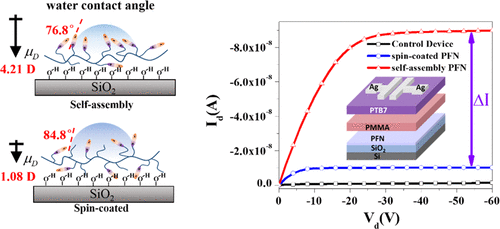当前位置:
X-MOL 学术
›
ACS Appl. Mater. Interfaces
›
论文详情
Our official English website, www.x-mol.net, welcomes your feedback! (Note: you will need to create a separate account there.)
Spontaneous Interfacial Dipole Orientation Effect of Acetic Acid Solubilized PFN
ACS Applied Materials & Interfaces ( IF 9.5 ) Pub Date : 2018-03-07 00:00:00 , DOI: 10.1021/acsami.8b00975 Cong Wang 1 , Yinqi Luo 1 , Jieming Zheng 1 , Linlin Liu 1 , Zengqi Xie 1 , Fei Huang 1 , Bing Yang 2 , Yuguang Ma 1
ACS Applied Materials & Interfaces ( IF 9.5 ) Pub Date : 2018-03-07 00:00:00 , DOI: 10.1021/acsami.8b00975 Cong Wang 1 , Yinqi Luo 1 , Jieming Zheng 1 , Linlin Liu 1 , Zengqi Xie 1 , Fei Huang 1 , Bing Yang 2 , Yuguang Ma 1
Affiliation

|
Poly[(9,9-dioctyl-2,7-fluorene)-alt-(9,9-bis(3′-(N,N-dimethylamino)propyl)-2,7-fluorene)] (PFN) is a very important interfacial modifier in organic photovoltaic and organic light-emitting diodes to improve device performance, where their molecular dipole has been regarded to play a key role. In this work, we have reported a spontaneous interfacial dipole orientation effect in acetic acid dissolved PFN, which is strongly related to the interfacial dipole and the corresponding device performance. In direct spin-coating, the interfacial dipole is 1.08 Debye with interfacial contact angle 84.8°, whereas after self-assembly of 10 min, the interfacial dipole is balanced at 4.21 Debye, with the interfacial contact angle decreasing to 76.8°. Without strong interaction with the substrate, the energy of upward amine groups is much lower than that of downward ones in theoretical simulation, which would be the driving force of this spontaneous process. The preferred conformations of PFN molecules on hydroxylated substrates have over 99% amine groups outward, and the theoretical average dipole calculated from the weight of these conformations is 4.48 Debye, which is close to the experimental result and indicates a high ratio of upward amine groups in self-assembled films. This effect obviously changes the device performance, such as an obvious positive threshold voltage shift in transistors and a distinct increase of the short-circuit current/open-circuit voltage in organic solar cells. This effect provides a deeper understanding of the PFN interlayer mechanism and has potential application in optoelectronic devices.
中文翻译:

乙酸溶解的PFN的自发界面偶极子取向效应
聚[(9,9-二辛基-2,7-芴)-alt-(9,9-双(3'-(N,N(二甲基氨基)丙基)-2,7-芴)](PFN)是有机光电二极管和有机发光二极管中非常重要的界面改性剂,可提高器件性能,其中分子偶极子在其中起着关键作用。在这项工作中,我们报告了乙酸溶解的PFN中的自发界面偶极子定向效应,这与界面偶极子和相应的器件性能密切相关。在直接旋涂中,界面偶极为1.08 Debye,界面接触角为84.8°,而自组装10分钟后,界面偶极平衡为4.21 Debye,界面接触角降至76.8°。在没有与底物的强相互作用的情况下,在理论模拟中,向上的胺基的能量比向下的胺基的能量低得多,这将是这一自发过程的驱动力。羟基化底物上PFN分子的优选构型向外具有超过99%的胺基,从这些构型的重量计算得出的理论平均偶极子为4.48 Debye,与实验结果相近,表明向上的胺基比例很高。自组装的电影。这种影响显然会改变器件性能,例如晶体管中明显的正阈值电压偏移以及有机太阳能电池中短路电流/开路电压的明显增加。这种效应提供了对PFN夹层机制的更深入的了解,并在光电器件中具有潜在的应用。羟基化底物上PFN分子的优选构型向外具有超过99%的胺基,从这些构型的重量计算得出的理论平均偶极子为4.48 Debye,与实验结果相近,表明向上的胺基比例很高。自组装的电影。这种影响显然会改变器件性能,例如晶体管中明显的正阈值电压偏移以及有机太阳能电池中短路电流/开路电压的明显增加。这种效应提供了对PFN夹层机制的更深入的了解,并在光电器件中具有潜在的应用。羟基化底物上PFN分子的优选构型向外具有超过99%的胺基,从这些构型的重量计算得出的理论平均偶极子为4.48 Debye,与实验结果相近,表明向上的胺基比例很高。自组装的电影。这种影响显然会改变器件性能,例如晶体管中明显的正阈值电压偏移以及有机太阳能电池中短路电流/开路电压的明显增加。这种效应提供了对PFN夹层机制的更深入的了解,并在光电器件中具有潜在的应用。这接近于实验结果,表明自组装膜中较高的向上胺基比例。这种影响显然会改变器件性能,例如晶体管中明显的正阈值电压偏移以及有机太阳能电池中短路电流/开路电压的明显增加。这种效应提供了对PFN夹层机制的更深入的了解,并在光电器件中具有潜在的应用。这接近于实验结果,表明自组装膜中较高的向上胺基比例。这种影响显然会改变器件性能,例如晶体管中明显的正阈值电压偏移以及有机太阳能电池中短路电流/开路电压的明显增加。这种效应提供了对PFN夹层机制的更深入的了解,并在光电器件中具有潜在的应用。
更新日期:2018-03-07
中文翻译:

乙酸溶解的PFN的自发界面偶极子取向效应
聚[(9,9-二辛基-2,7-芴)-alt-(9,9-双(3'-(N,N(二甲基氨基)丙基)-2,7-芴)](PFN)是有机光电二极管和有机发光二极管中非常重要的界面改性剂,可提高器件性能,其中分子偶极子在其中起着关键作用。在这项工作中,我们报告了乙酸溶解的PFN中的自发界面偶极子定向效应,这与界面偶极子和相应的器件性能密切相关。在直接旋涂中,界面偶极为1.08 Debye,界面接触角为84.8°,而自组装10分钟后,界面偶极平衡为4.21 Debye,界面接触角降至76.8°。在没有与底物的强相互作用的情况下,在理论模拟中,向上的胺基的能量比向下的胺基的能量低得多,这将是这一自发过程的驱动力。羟基化底物上PFN分子的优选构型向外具有超过99%的胺基,从这些构型的重量计算得出的理论平均偶极子为4.48 Debye,与实验结果相近,表明向上的胺基比例很高。自组装的电影。这种影响显然会改变器件性能,例如晶体管中明显的正阈值电压偏移以及有机太阳能电池中短路电流/开路电压的明显增加。这种效应提供了对PFN夹层机制的更深入的了解,并在光电器件中具有潜在的应用。羟基化底物上PFN分子的优选构型向外具有超过99%的胺基,从这些构型的重量计算得出的理论平均偶极子为4.48 Debye,与实验结果相近,表明向上的胺基比例很高。自组装的电影。这种影响显然会改变器件性能,例如晶体管中明显的正阈值电压偏移以及有机太阳能电池中短路电流/开路电压的明显增加。这种效应提供了对PFN夹层机制的更深入的了解,并在光电器件中具有潜在的应用。羟基化底物上PFN分子的优选构型向外具有超过99%的胺基,从这些构型的重量计算得出的理论平均偶极子为4.48 Debye,与实验结果相近,表明向上的胺基比例很高。自组装的电影。这种影响显然会改变器件性能,例如晶体管中明显的正阈值电压偏移以及有机太阳能电池中短路电流/开路电压的明显增加。这种效应提供了对PFN夹层机制的更深入的了解,并在光电器件中具有潜在的应用。这接近于实验结果,表明自组装膜中较高的向上胺基比例。这种影响显然会改变器件性能,例如晶体管中明显的正阈值电压偏移以及有机太阳能电池中短路电流/开路电压的明显增加。这种效应提供了对PFN夹层机制的更深入的了解,并在光电器件中具有潜在的应用。这接近于实验结果,表明自组装膜中较高的向上胺基比例。这种影响显然会改变器件性能,例如晶体管中明显的正阈值电压偏移以及有机太阳能电池中短路电流/开路电压的明显增加。这种效应提供了对PFN夹层机制的更深入的了解,并在光电器件中具有潜在的应用。



























 京公网安备 11010802027423号
京公网安备 11010802027423号